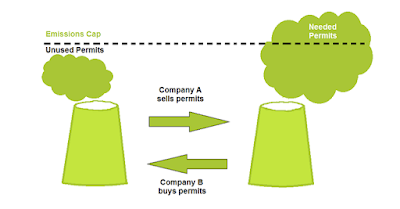Emissions Trading

What is emissions trading? Emissions trading is essentially a market-based cap-and-trade system where a cap on the limit of emissions is set and emitters buy the right to emit in the form of permits where each permit is usually equal to one tonne of CO2 equivalent. The overall cap and with it the overall number of tradable permits decreases every year by a fixed percentage to gradually drive up the cost of fossil fuels and incentivise emitters to utilise cleaner technology to emit less. Allowing permits to be traded allows flexibility in terms of how and where pollution is reduced and allows the market to put a price on pollution; the price per permit is the cost of emitting one tonne of CO2-eq. The figure below depicts the working principle. Companies with high abatement costs deem it more economical to purchase permits from companies - typically those with low abatement costs - than to actually procure new machines. Principle of cap and trade Who is subject to an e